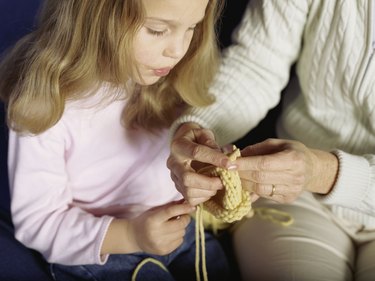
S1 is a knitting abbreviation for "slip stitch," which means to pass the next stitch over to the opposite needle without knitting or purling it. There are multiple places where a slip stitch can be useful, whether it be decreasing a hat or creating a nice even edge on a piece of work.
Defining the S1
Video of the Day
S1 is translated into "slip one," which refers to a slip stitch. There are a few different abbreviations used for the S1 stitch, including:
Video of the Day
- Sl1
- SlSt
- Sl
- St
In knitting, these terms all mean to pass a stitch to the next needle without knitting or purling the stitch.
Performing the S1
To create an S1, take the working needle in the right hand and the needle with the stitches on it in the left hand. To S1 knitwise, push the working needle through the bottom of the stitch in the same direction the left-hand needle is facing. Let the stitch slide off of the left-hand needle and onto the working needle.
To S1 purlwise, slide the working needle through the bottom of the stitch, but in the opposite direction of the left-hand needle. Pull back on the working needle so that the stitch stays on it instead of the left-hand needle.
Generally, a pattern that says S1 will almost always refer to S1 purlwise, unless otherwise mentioned.
Using a S1
S1 is most commonly used as a way to decrease in knitting. However, just slipping a stitch doesn't decrease the amount of loops, so other stitches have to be paired with the S1.
SKPO means "slip, knit, pass over" and refers to S1, knit one stitch, and then pass the slipped stitch over the knitted stitch. Passing the slipped stitch over makes the decrease line lean leftward instead of rightward, which is what decreasing by knitting two stitches together does. Thus, SKPO is similar to just knitting two stitches together to create one stitch, but SKPO allows for a different lean in the resulting work.
S1 is also used to create flat edges on garments that are knitted flat, such as scarves. To create a nice edge, simply S1 the first stitch when knitting the next row. This stops the work from twisting or leaving bumpy edges.
Creating a Double Knit
A special technique for slipping stitches is that the yarn can be passed behind the work instead of leaving it to work in the front. This is called a WYIB or "with yarn in back" and it makes the slipped stitch invisible. Likewise, WYIF creates a loop in the front of the work that can then be worked.
S1 WYIB and S1 WYIF can thus be used to move the working yarn front and back, enabling a double knit, and very warm, garment. To create a tubelike double knit work only use S1 WYIF, and when the work is turned, only knit the S1 stitches.